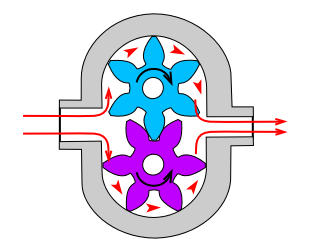Types
Types of fluid pumps
Types Of Pumps
There are two basic categories of pumps: 1. Constant Volume Pumps. 2. Constant Pressure Pumps.Constant Volume Pumps
- Constant volume pumps are also known as Constant Displacement pumps in engineering circles. Amongst Constant Volume pumps, there are four types used in aircraft applications.
a. Gear Type pumps.
b. Vane Type pumps.
c. Gerotor pumps.
d. Piston pumps.
Constant displacement pumps deliver a fixed volume of fluid at low, medium, or high pressure, depending on the needs of the system.
Vane Type Pump
The vane pump uses two-to-four steel vanes that are free-floating in slots cut in the rotor. As the rotor turns in the direction shown by the arrow, the volume of fluid between the vane and the inlet side of the pump increases, while the volume between the vane and the discharge side of the pump decreases. This change in volume pulls fluid in through the inlet port, and forces fluid out through the discharge port.
 Login
Login


